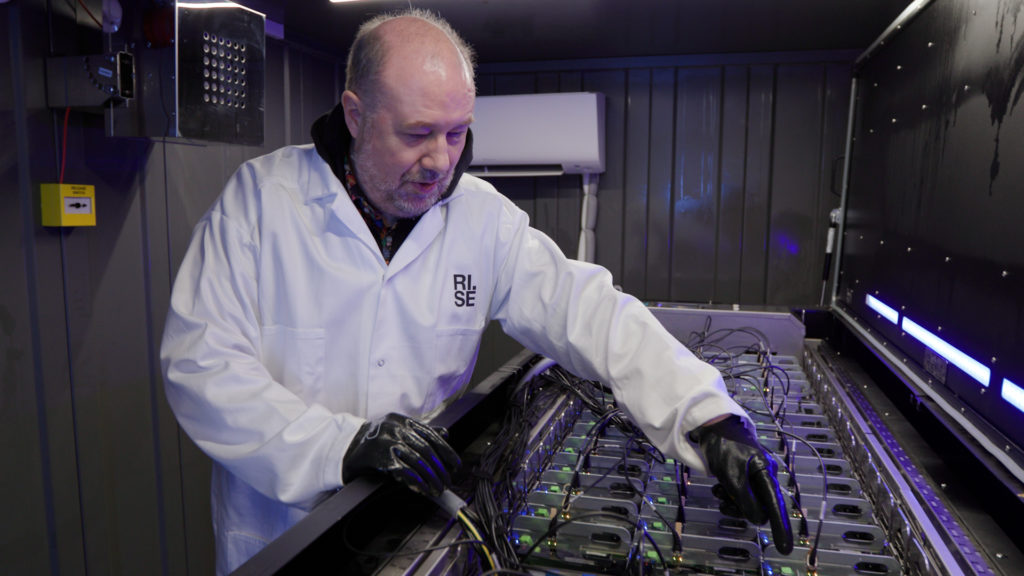The Horizon 2020, European funded WEDISTRICT project wants to test and develop solutions for implementing renewable energy systems in district heating and cooling around Europe, bringing together several partners from 9 countries in Europe with demosites in Romania, Sweden and Spain. The new video “The Luleå demosite – Fuel cell powered data centre with waste heat recovery” shows how the researchers from RISE Sweden managed to implement a system to increase the energy efficiency of this data centre by combining biogas, fuel cells and novel liquid cooling technology.

On 25th July 2023 the newly amended EU Directive on energy efficiency (Directive 2023/955) was published. Large data centres will have an obligation to collect data about their energy uses. Specifically, they must report “how much of it comes from renewable energy sources, the reuse of any waste heat it produces” and “effectiveness of cooling”. This directive will affect all bigger data centres in the European Union.
But it did not come as a surprise. According to a study conducted in the framework of the EU Digital Strategy, data centres are projected to consume 3.21% of the overall energy demand of the European Union. One main goal of the Strategy was therefore to move towards “highly energy-efficient and sustainable data centre’s” in order to reach the overall reduction targets of the EU energy consumption by 11.7%.
Currently, it is the task of national governments to implement this new directive into its laws. In Germany, this combines with other legislation on heating for buildings – specifically on district heating and effective waste heat usage, as mentioned by the Federal Minister for Housing, Urban Development and Building, Klara Geywitz at the press conference for the district heating summit on 12th June 2023, the Twitter post of the general secretary of the social democratic party in Germany Kevin Kühnert on 15th June 2023. The German version of this energy efficiency law had to be delayed into the first weeks after the summer break 2023 due to some issues in the German parliament (source: Euractive).
The Horizon 2020 European funded WEDISTRICT project, which started in October 2019 with a budget of almost 18 million EUR, wants to test and develop solutions for implementing renewable energy systems in district heating and cooling around Europe, bringing together several partners from European 9 countries. The project has demonstration sites in different European climates: Romania, Spain and Sweden. To figure out how renewable energy sources can be used in data centres and how to recover their waste heat was the goal of the project WEDISTRICT at Luleå, Sweden.
The northern Swedish city of Luleå has a subarctic climate, making it attractive for companies such as Facebook, who placed their first large data centre outside the US here in order to cool their database servers with outside air (source: Spiegel). This reduced the energy required for cooling but impacts local waste heat usage instead of greenhouse gas emissions.
The WEDISTRICT researchers at the Infrastructure and Cloud Research & Test Environment of the Research Institutes of Sweden (RISE ICE Datacentre) in Luleå had a different approach. In the new WEDISTRICT demosite video, Jon Summers and Jonas Gustafsson from the RISE ICE Datacentre, explain the different components, the necessary modification of their setup at the demonstration site in Luleå, Sweden and potential challenges and opportunities.
“The objective of this demo site is to demonstrate the use of data centres in combination with fuel cells to achieve heat recovery from data centre and fuel cells directly into district heating systems without the use of heat pumps” says Jonas Gustafsson, Research Program Manager at RISE.
With a zero-emission fuel like green hydrogen, they wanted to power a small data centre via fuel cells. At the same time, they wanted to use its waste heat for district heating via a liquid cooling technology. Due to the lack of availability of green hydrogen and a respective solid oxide fuel cell, they had to use local biogas instead.
“The high temperature solid oxide cells have to run on a form of methane. We are using locally produced biogas. It still has a carbon intensity, but a lower carbon intensity than if we would just allowing the organic waste to just decompose into the environment. So, it is a way of capturing that” says Jon Summers, Research Leader at RISE.
This WEDISTRICT’s demo site aimed to recover the excess heat from the data centres by liquid cooling technology. This technology uses a dielectric liquid where the commercial servers can be completely immersed and transfer their waste heat to the liquid. Via heat exchangers this heat could then be further utilized to preheat the fuel cell container. The fuel cells were used to boost the system to temperatures suitable for supplying the Luleå’s district heating.
The fuel cells produced direct current electricity power as well as a huge amount of waste heat for potential recovery.
The video “The Luleå demosite – Fuel cell powered data centre with waste heat recovery” was released on 15th August 2023 at 10:00 CEST on the WEDISTRICT playlist of the YouTube ESCI channel.
For more information on the Luleå demo site, check out our website. Read more about the technology in this article, published in the July edition of Heat Exchanger World.
The YouTube video and/or higher resolution footage and b-roll material is available upon request from Lea (email: lhs@esci.eu).